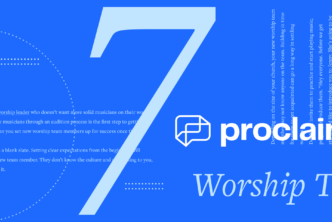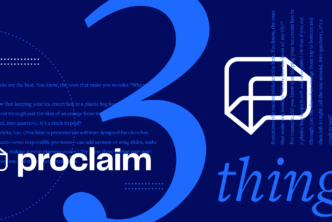J. D. Greear is the lead pastor of The Summit Church in Raleigh-Durham, NC, and the author of several books, including Stop Asking Jesus into Your Heart. We had a few minutes to chat with him about how they approach worship at The Summit Church.
Worship artist Matt Papa also calls The Summit Church home, and given how much we value leadership-team collaboration, we were curious to hear about how the team works together.
The multisite approach The Summit has embraced carries its own set of challenges, like keeping eight different campus pastors and eight different worship leaders on the same page each week. What does the service-planning process look for you?
God tells us in John 1 that He reveals himself to us through Christ. That’s why we strive to make all our worship and teaching “layered,” repeating the same content multiple times, but in multiple different ways—through my sermons, small group curriculum, worship songs, video clips, blog posts—all together pointing to the cross. A lot of preaching in the church today says, ‘Now go and change,’ but Gospel preaching changes you on the spot. Worship is a rhythm of revelation and response. God reveals aspects of his character to us, through the cross of Christ, and we respond to it.
Ideally, I can let the team know what aspect of God’s character I plan to highlight far enough in advance to give us time to make plans. Then, every Wednesday, the whole team, all the worship leaders and campus pastors, meet about the current week’s service. By that point, the message is pretty much done, so we’re able to refine the details.
We treat the whole 80–90 minute service as a single unit of revelation/response. Communication is more effective when it is layered, and we really try to frame the whole thing as a single unit. Scripture reading is always an important part of what we do—sometimes the specific passage I’m preaching from, sometimes not. There’s almost always a moment when the worship leader points out the connection between the Scripture and the songs which we’ve either written or chosen.
Where do the series ideas come from? Is that something you do on your own, or do you have a committee or team?
We don’t have an official committee, but I’m in constant dialog with the campus pastors to choose passages and topics.
There are always two kinds of planning going on at once: long-term and short-term. The short-term refinement and detailed planning is done in our Wednesday meeting. In the long term, though, we’re mapping out the big picture of a sermon series several months ahead of time.
I love John Stott’s portrait of a preacher. He says that a preacher is a steward. The Father decides what the children eat, but the steward arranges it into meals. We’re aiming for a balanced diet, so in a given year, I want to cover something from the life of Jesus, teach through a book, and cover a Christian living or wisdom series like marriage or finance or something like that.
As I listen to Matt Papa’s albums, I noticed that his songs are generally more outreach-oriented than those of a lot of other worship artists, which isn’t surprising, given the values of The Summit. Do you commission him to write toward a specific topic/theme, or does he bring songs to you after they’ve been written?
Yes to both. We’re friends, so a lot of it happens organically. As we hang out at my house, watching a basketball game or something, he’ll often ask me, “Hey, what are you thinking of preaching about in the next year?” I’ll tell him, and he’ll latch on to specific passages or ideas. Then, when it comes up in planning, he’s ready with a song that he’s written. Other times, we’ll get together and I’ll say to him, “We really need a song that captures the heart of this series, and there’s not really one out there. Could you or one of the other worship leaders write one?” He just did that recently for a series that we did called “All In.” He wrote a song that I believe was just called “All.”
Easter is a major outreach opportunity for most churches, and you’ve capitalized on it using on-the-spot baptisms. Could you share where that idea came from and the rationale behind it?
I don’t mean this to sound trite or sarcastic, but the idea really came from the New Testament. Every baptism recorded in Scripture happens spontaneously, so we just modeled our Easter service after that.
I grew up in a tradition that placed value on the altar call. I remember a Gospel invitation every week, and every week we did the walk-forward thing. That can be dangerous because it can create an artificial environment for salvation, but the golden nugget there is the call for a moment of decision, and baptism is the action that God has given us to mark a decision to trust Christ.
We don’t do it every week, and when we do, we try to be really responsible with it, and send every person who responds through some really systematic counseling. We aren’t afraid to turn people away. If we feel that someone doesn’t quite understand, we say, “let’s revisit this in a week or so.”
This Easter, the theme seemed to be “Jesus in My Place.” I saw it on baptism T-shirts, and of course I’ve heard the song that Matt wrote by that title. Where did that start? Was it proposed, or did it evolve organically?
That’s a phrase I repeat a lot. “Jesus in my place”—it’s in the Gospel in four words. I preached about it three or four years ago, and it really stuck in the minds of some of our worship leaders. Actually, we theme all our baptism services, not just the Easter ones.
What advice would you have for aspiring worship leaders?
Learn outside your camp. Figure out what your base is, but celebrate the diversity of gifts in the body of Christ by learning from those outside your own circle.
For more from J. D. Greear, pick up his new book Stop Asking Jesus Into Your Heart.




